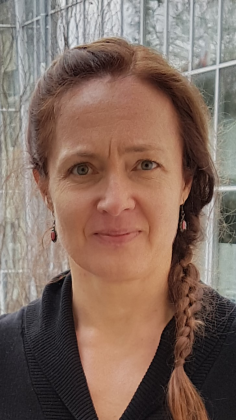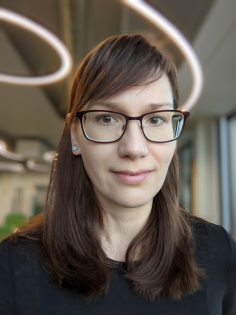People in the Soil Ecology Workgroup

Prof Maarja Öpik, Professor, PI, maarja.opik@ut.ee (+372-5053410)
The main focus of my research has been the molecular detection and identification of arbuscular mycorrhizal (AM) fungi (subphylum Glomeromycotina). I have been at the forefront of molecular AM fungal research by developing DNA sequence-based nomenclatural system for Glomeromycotina with the goal to link the specimen (culture-) originating and environmental sequence information. This system of virtual taxa (VT) is implemented in the database MaarjAM, which collates published information about Glomeromycota sequences and related metadata (location, host, habitat information). Our team continues developing the system, as the data volumes and types continuously progress.
With the Virtual Taxon tool in our hands and accumulating ecological content of MaarjAM database, we look into the lives of AM fungi in natural and (strongly) human impacted habitats, in interaction with other micro-and macro-organisms and in relation to the functioning of the ecosystems.
On the applied side, we are exploring how to make use of AM fungi and soil biota for restoring vegetation, for directing succession of vegetation and in sustainable agricultural production. Much of this research happens in collaboration with our research partners and partners in the field.
I contribute as academic editor for the journals New Phytologist, Fungal Ecology and IMA Fungus.
Current projects:
- Soil fungi in the farming landscape (FUNFARM, Personal Research Grant PRG PRG1789; Maarja Öpik)

PhD Inga Hiiesalu, Research Fellow in plant ecology, inga.hiiesalu@ut.ee
I am broadly interested in plant community ecology, with the focus on the belowground compartment. Specifically, I am investigating how the diversity of plant-symbiotic fungi varies along different environmental gradients, and what are the abiotic and biotic factors underlying the observed patterns. I am currently leading a project dealing with arbuscular mycorrhizal fungi along elevational gradient in the Himalayan Mountains, and I am fascinated by the ability of fungi and plants to grow in some of the most hostile and extreme environments on Earth. My research also addresses land-use impact on soil biodiversity in agricultural landscapes. I’m interested in how various agricultural practices (organic vs conventional agriculture, regenerative agriculture, pesticide use) influence soil life, namely mycorrhizal fungal diversity and related ecosystem functions. I utilize next-generation sequencing, bioinformatical tools and multivariate statistics to analyze mycorrhizal communities across various spatial scales. I have international work experience (Canada, Czech Republic, Germany) and I have attended scientific expeditions in Iceland, Mongolia, Tasmania, the Himalayan mountains and Mexico. During the last 10 years, I have published nearly 40 high-level scientific publications, which have been cited more than 2800 times (H=23) according to Google Scholar.
Current projects:
- Soil fungi in the farming landscape (FUNFARM, Personal Research Grant PRG PRG1789; Maarja Öpik)
- Arbuscular mycorrhizal fungi along altitudinal gradients: relationships with evolutionary and ecological processes at multiple spatial scales (Personal Research Grant, Starting project PUT1170; Inga Hiiesalu)
- Interactive effects of local and landscape scale restoration of semi-natural grasslands and agricultural fields on species interactions and ecosystem functions (Interrest, Aveliina Helm)

PhD Tanel Vahter, Research Fellow in soil ecology, tanel.vahter@ut.ee
I am broadly interested in ecology, but my research is mainly focused on topics related with soil. Soil is central to many ecosystem processes and the driving force behind is soil biota. For this reason my research is tightly connected with the diversity and dynamics of soil biota. I’m especially interested in systems where soil use and ecology meet in practice – agriculture, seminatural communities, ecosystem restoration in practice and etc. I feel especially happy when I can use knowledge and experience from basic studies to tackle problems in soil and nature conservation.
Current projects:
- Test battery for the effect determination of chemicals in soils: Suitability of test systems with mycorrhiza fungi for the risk assessment (ERAMYC, Mari Moora)
- Soil fungi in the farming landscape (FUNFARM, Personal Research Grant PRG PRG1789; Maarja Öpik)
- Interactive effects of local and landscape scale restoration of semi-natural grasslands and agricultural fields on species interactions and ecosystem functions (Interrest, Aveliina Helm)
PhD Students

Siqiao Liu
The aim of my PhD project is to disentangle the effect of different land-use disturbances on the communities of arbuscular mycorrhizal fungi (AMF) and understand how disturbances influence the restoration of these communities. During my PhD study, I will examine if mechanical and chemical disturbances differ in their effect on AMF and their restoration potential. In addition, I will try to find out if AMF, which respond to specific disturbances, share some characteristics (e.g. growth rate, hyphal density, etc.). With this knowledge we can improve our predictions about the effect of disturbances on AMF in the future.
My supervisors are Kadri Koorem and Maarja Öpik.

Yiming Meng
I aim to answer the following question during my PhD studies: 1) what are the roles of phylogeny vs environmental conditions in determining the mycorrhizal status of plant species? 2) is there a common set of geographic, environmental or phylogenetic contexts that explains why some plants do not form mycorrhizal symbiosis? 3) do fungal communities associating with plants being always and sometimes mycorrhizal differ in relation to one another and in relation to biotic and abiotic environmental factors? I hope to provide new empirical information about how plant mycorrhizal traits change along environmental gradients and predict mycorrhizal fungal traits and plant communities in changing ecosystems.
My supervisors are Guillermo Bueno, John Davison and Maarja Öpik.

Ayesh Piyara Wipulasena Aleihela Yamannalage
My research involves the study of how microorganisms function as an agent and co-driver of ecosystem transition between alternative stable states. The study attempts to understand underlying mechanisms and to propose means to mitigate the negative effects of perturbed ecosystems.
I am conducting my research under the guidance and supervision of Prof Mari Moora, Assoc Prof John Davison, and Dr. Tanel Vahter.

Oscar Zárate-Martínez
My PhD studies focus on understanding the distribution of soil fungi, applying species distribution modeling and dark diversity methodologies along with big data on soil organisms. I aim to estimate how the distribution of soil fungi can contribute to ecosystem services such as ecosystem capacity to store carbon, mushroom picking, ecotourism, etc., and improve the planning of ecosystem conservation.
My supervisors are Professor Meelis Pärtel (Macroecology workgroup) and Professor Maarja Öpik.
